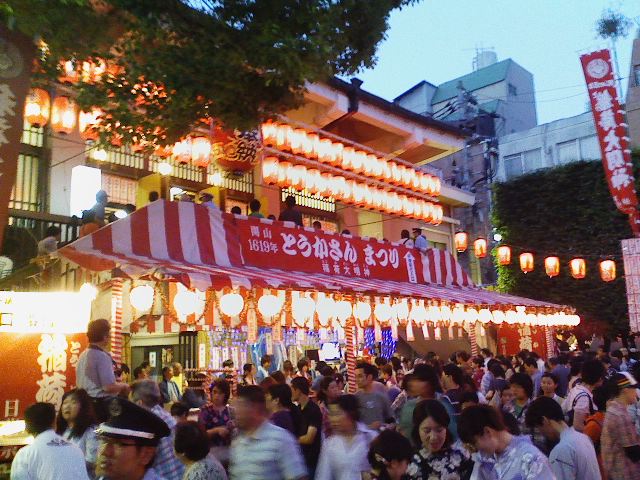May 29, 2018
Hiroshima’s Toukasan Festival

For four hundred years, Hiroshima’s Toukasan festival has marked the arrival of summer for locals. Stretching over three days on the first weekend in June, the festival is officially in honor of Touka Daimyoujin, a deity enshrined at Enryu-ji, a temple one block north of Peace Boulevard on Chuo-dori. Also known simply as Toukasan, the temple was built by Asano Nagaakira, the first of the Asano lords who would rule the Hiroshima Domain until the close of the Edo period, shortly after his arrival from Wakayama in 1619. The present-day structure isn’t exactly an architectural splendor, and can seem utterly deserted for most of the year, but during the festival people line up down the block to pass through Enryu-ji’s gate and offer their prayers.
The festival is enormously popular, and huge crowds descend on Chuo-dori, which in the evenings is closed to traffic for a stretch to make space for taiko drumming and other performances. A key feature of Toukasan is the wearing of the casual, lightweight summer kimono called ‘yukata.’ Young girls and women move in gaily colored clusters through the festival, calling out excitedly to friends and taking, at a conservative guess, hundreds of thousands of photographs of one another in their festival yukata and hairstyles.
Men wear yukata as well, albeit less colorful, and the most stylish stroll the festival in the wooden sandals called geta, producing a musical clatter that is instantly recognizable as the sound of Japanese at leisure. Many festival-goers will also be clutching ‘yakuyoke uchiwa,’ specially decorated fans associated specifically with Toukasan and intended to drive away ill fortune. Overseas visitors to the festival often wear yukata too, and there are several places around town that will help you get properly decked out. The International Center on the 6th floor of the Crystal Plaza building on Peace Boulevard is a good place to ask, if you’re interested. A number of shops in the Hondori shopping arcade are also willing to help out, often for no more than the cost of the yukata itself (unlike the more formal kimono, they can be had for under 5000 yen) plus 500 yen or so to get it properly strapped on.
In fact, you may think as you wander the games and food stalls that Toukasan is primarily for the young. As usual, the answer is yes and no. Toukasan is for the entire city, and if you drop by Shintenchi Park, a half-block east of Chuo-dori, you’ll find Hiroshima locals of all ages dancing gracefully in a strolling circle around a tower erected at the center of the square. The music is decidedly old school, and about the most exciting part of the night is when Issei Minami, a beloved local enka singer, clambers up the ladder to thrill the grandmothers with ‘Nagarekawa Tengoku,’ his timeless paean to Hiroshima’s drinking district. For a number of years, I avoided this whole scene, but then one evening I let a few people show me the steps, sat out a couple of tunes to chat with locals over beer, then sang along as best I could when the above-mentioned enka singer led the crowd in the Hiroshima Carp fight song. Ever since, the dancing in Shintenchi Park has seemed like the true heart of Toukasan. Do stop by and check it out.
Time: Every first weekend in June, Friday to Sunday. Chuo-dori closed to traffic 19:00 to 22:00 Friday and Saturday.
Location: Events around downtown, but the heart of the festival is along Chuo-dori from Peace Boulevard north to Hatchobori.
noppo3 [CC BY-SA 3.0], via Wikimedia Commons


About the author